TAKEO Province
 Takeo is best described as the oldest province rich in tourist destinations, and specifically in historic of the era of Anachak Phnom and Chenla. Simply being close to the capital city of Phnom Penh, Takeo easily wins the most numbers of day trips. Not only is Takeo home to the legacy of the six ancient temples, but also home to some often-visited resorts such as Tonle Bati, Phnom Ta Mao(zoo,) Chi So mountain, Neang Khmao Temple, and many more.
Takeo is best described as the oldest province rich in tourist destinations, and specifically in historic of the era of Anachak Phnom and Chenla. Simply being close to the capital city of Phnom Penh, Takeo easily wins the most numbers of day trips. Not only is Takeo home to the legacy of the six ancient temples, but also home to some often-visited resorts such as Tonle Bati, Phnom Ta Mao(zoo,) Chi So mountain, Neang Khmao Temple, and many more.
Administration
- The province is subdivided into 12 districts, 100 communes and 907 villages.
- Time zone UTC+07
- Dialing code +855
- ISO 3166 code KH-17
- Population People(2008)
- Total 896,309
- Density 87/km2 (225.4/sq mi)
-
- Area - Total 10,299 km2 (3,976.5 sq mi)
Tours in Takeo Province:
Tonlé Bati Resort

 The Tonle Bati Resort in Takeo Province is an example of Cambodia’s economic growth. Many years ago, there was no domestic tourism. “Hanging out by the river” was an activity for foreigners. But now, official statistics and other sources say that the Tonle Bati Resort entertains about 100 domestic tourists every day. Along the river, hundreds of huts made of straw and wood have been constructed. Busloads of families come to relax in the huts and to watch the river flows as they enjoy food and beer. Children jump at the chance to swim and play with water. Others embark on hour-long trips on traditional fishing boats to visit an ancient pagoda on a nearby island or to fetch some fresh lotus. Cambodian tourism destinations, unlike amusement parks in the West, always bring a sense of tranquillity and refreshment. They remind me of the beauty of nature as well as the treasure of friendship as Savon, Ippei, Ti-yang and I sat for hours in this October morning chatting and laughing.
The Tonle Bati Resort in Takeo Province is an example of Cambodia’s economic growth. Many years ago, there was no domestic tourism. “Hanging out by the river” was an activity for foreigners. But now, official statistics and other sources say that the Tonle Bati Resort entertains about 100 domestic tourists every day. Along the river, hundreds of huts made of straw and wood have been constructed. Busloads of families come to relax in the huts and to watch the river flows as they enjoy food and beer. Children jump at the chance to swim and play with water. Others embark on hour-long trips on traditional fishing boats to visit an ancient pagoda on a nearby island or to fetch some fresh lotus. Cambodian tourism destinations, unlike amusement parks in the West, always bring a sense of tranquillity and refreshment. They remind me of the beauty of nature as well as the treasure of friendship as Savon, Ippei, Ti-yang and I sat for hours in this October morning chatting and laughing.
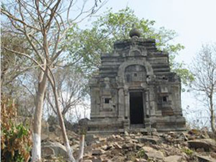
 There're two museums have been established in Takeo province, one located at Angkor Borei district nearby the Phnom Da temple and the other is in the centrall part of Takeo town. This provincial museum is one of the most interesting design and layout which adopted to the most artistic style to Phnom Da architectural arts. Most of the cultural items are collected from local people in the Ta Keo area. The museums are daily opened from 8-11am and 2-5pm from Monday to Saturday, the entry fee is 1$ per adult foreign-visitors.
There're two museums have been established in Takeo province, one located at Angkor Borei district nearby the Phnom Da temple and the other is in the centrall part of Takeo town. This provincial museum is one of the most interesting design and layout which adopted to the most artistic style to Phnom Da architectural arts. Most of the cultural items are collected from local people in the Ta Keo area. The museums are daily opened from 8-11am and 2-5pm from Monday to Saturday, the entry fee is 1$ per adult foreign-visitors.Phnom Kleng Mountain
Ta Mok House
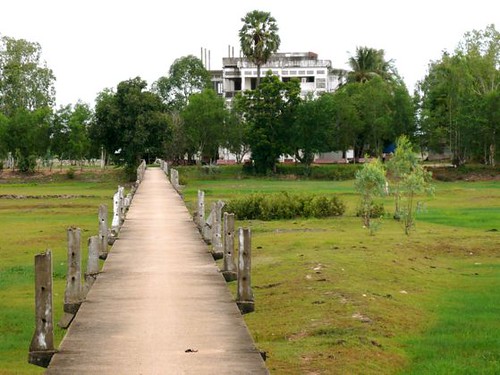
At the center fresh water lake of Takeo town, sits a house that was built by Ta Mok. The house was built in the 1977 to be used for his private residency during the Pol Pot regime between 1975-79. The house sits on top of a hill with 360 degree scenic view. From the main dirt road, one can walk to the Ta Mok's house by crossing the concrete bridge across the meters long. Construction of the house, is massive comple about 1 ht square and 3 story high, with 20*30 of concrete inside the house. Today, Ta Mok's house is now used as an educational centre for police officers.
Ta Mok was know as the cruel leader and was a military commander of the Cambodian Khmer Rouge movement. he was responsible for the deaths of thousands of people during the Pol Pot regime. He was born in Takeo province in 1924. he spent 10 years in Phnom Penh prison at the end his life and died in 2006.
Ta Nhean temple
Phnom Bayong Koa Temple
Some 40 km. away from the central city of Takeo province, there are two group ruins that dated back to Pre-Angkor period. At the temple site there is the bigger one is called Bayong Koa. and the smaller ruin called Ta Nhean temple.
Sounding the temples are green luscious forest and fresh heavy smell of the jungle. The details and construction of the Those who do visit ancient temple at points forego the stair-case altogether, leaving the path to pick their way through scrub and over large stones, ducking beneath the hanging limbs of mango and jackfruit trees. It takes a good pair of shoes to make this climb. And while the 390 stairs that rise more than 300 meters to the foot of the Bayong Koa temple may not be the easiest walk. The ample serenity and natural beauty of a visit to Bayong Koa, which sits atop Bayong Koa mountain. The Bayong Koa temples where erected in the early 7th century by King Bhavaman I in homage to the Hindu god Shiva. Built of brick, laterite and sanstone, the temple is stylistically Sambo Prey Kuk. Located in Pour Roang Village, Preah Bat Chann Chum commune, Kirivong district. The Bayong Koa temple is 121 kilometers from Phnom Penh along National Road 2. There are no vendors at the temple, so bring plenty of water and snacks with you.
Phnom Da and Phnom Borei
Visiting a silk and Kroma manufacturing village

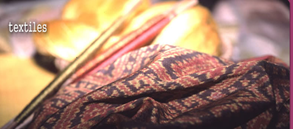 Cambodian farmers make traditional silk all throughout the kingdom but for day tripping, it may convenient to visit serveral interesting places such as Pea-ream and Thnoat communes in Bati district, and Tang Yab and Say-va commune in the Samrong district of Takeo province. At Tang Yab villages, well know as a 'weaving handicraft village,' is on one of the largest village located nearby Chiso temple, it's about 4 kilometres from the leg of mountain, and is about 65 kilometres from Phnom Penh.
Cambodian farmers make traditional silk all throughout the kingdom but for day tripping, it may convenient to visit serveral interesting places such as Pea-ream and Thnoat communes in Bati district, and Tang Yab and Say-va commune in the Samrong district of Takeo province. At Tang Yab villages, well know as a 'weaving handicraft village,' is on one of the largest village located nearby Chiso temple, it's about 4 kilometres from the leg of mountain, and is about 65 kilometres from Phnom Penh.
The villagers have retained their traditional lifestyle based around their main handicraft, traditional silk weaving, Phamoung, Hol, Krama and cotton clothes. Visitors walking the villager trail around the village will hear the sound of looms emerging from every house. Their many good weaving products are available for visitors to order or just buy it from these producer hand with a reasonable price.
Neang Khmao
 Neang Khmao temple is located in Rovieng commune, Samrong district, off National Road 2, about 27 kilometers north of Takeo provincial town or about 52 kilometers south of Phnom Penh. This temple is inside Wat Neang Khmao.
Neang Khmao temple is located in Rovieng commune, Samrong district, off National Road 2, about 27 kilometers north of Takeo provincial town or about 52 kilometers south of Phnom Penh. This temple is inside Wat Neang Khmao.
Constructed of sandstone and brick in the style of Koh Ker, the temple was built by King Jayavarman IV (AD 921-941) in the 10th century for the worship of Brahmanism. The site originally consisted of three temples built side by side, however, only two are still standing, and both are heavily damaged.
The Neang Khmao Temple, Takeo is considered among the most popular tourist attractions in Takeo. Takeo is a beautiful province in Cambodia, specked with several places of interest that are natural or manmade. There are a number of grand temples in Takeo. Among these temples, the Neang Khmao Temple, Takeo is certainly worth a visit on your tour to Takeo.
The Neang Khmao Temple, Takeo is also known as the temple of the Black Virgin. According to legends, this temple might once have been the haven to Kali, the Dark Goddess of Destruction. It is positioned in the yard of Neang Khmao pagoda at Ro Vieng Commune of Sam Roung District in Takeo province. This magnificent temple was built by King Jarman IV during the 10th century. The temple is made of sandstone and brick, following the style of Thmor Koh Keo. However, most parts of the Neang Khmao Temple in Takeo have been damaged over the years.
There is a tale related to the Neang Khmao Temple in Takeo. Long time ago, there was a powerful king named Preah Bat Sorya Teyong, who stayed on the Chiso Mountain. One day, his 16-year-old daughter, Neang Khmao, went to Tonle Protron. Present over there was a handsome man, Bandit Srey, who instantly fell in love with her. He exhibited some magic, which made the princess fall in love with him. When the king came to know about this, he ordered that the princess be exiled, for which he built two temples. After being exiled, she met a monk named Keo, and fell in love with him. Later, Keo gave up being a monk to live happily with the princess in the temple. Since then this temple has been called the Neang Khmao Temple, Takeo. The Neang Khmao Temple, Takeo is located 52 kilometer south of Phnom Penh and is at a distance of 26 kilometers from the provincial town of Takeo. Hence, reaching this temple is not a problem at all.
Prasat Neang Khmao is located in Rovieng commune, Samrong district, Takeo province. The tale related to this temple is as the following: Then he told his daughter, Neang Khmao to live there. Since then, Princess Neang Khmao was very sad because of exiling and living alone and she never met her sweetheart who she heard nothing. At that time, there was a monk, Keo, who left home land to study magic. He was highly educated. He came back to home land and stayed in a place in Takeo province. The villagers digged a pond for him which was later called Srah Keo ( Keo's pond ) until nowadays. He stayed so long that he became well known in all villages and districts.
Having heard that, princess Neang Khmao wanted to meet him in order to know about her sadness and happiness. So she asked the servants to arrange royal seat on elephant's back to salute the teacher Keo. When she arrived she entered to salute the teacher Keo traditionally and she saw all appearances of teacher Keo so she forgot her old sweetheart and fell in love with teacher Keo. Since then the relationship between Princess Neang Khmao and teacher Keo was getting closer and closer that teacher Keo decided to leave from being a monk in order to be a layman to share happiness and pain with princess in the temple. Because of such a tale that it was called Neang Khmao temple until now.
Phnom Chiso
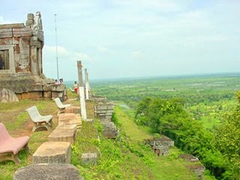 Phnom Chiso is a historical site located in Sia village, Rovieng commune, Samrong district, about 62 kilometers south of Phnom Penh or 27 kilometers north of Takeo provincial town. To reach the site, take National Road 2 to Bati district and Neang Khmao temple. Turn right at the sign for the site and head down the dirt trial for 5 more kilometers. Phnom Chiso is 13O-meter-high mountain.
Phnom Chiso is a historical site located in Sia village, Rovieng commune, Samrong district, about 62 kilometers south of Phnom Penh or 27 kilometers north of Takeo provincial town. To reach the site, take National Road 2 to Bati district and Neang Khmao temple. Turn right at the sign for the site and head down the dirt trial for 5 more kilometers. Phnom Chiso is 13O-meter-high mountain.
Phnom Chiso temple was built in the early 11th century by King Suryavarman I (AD 1002-1050), who practiced Brahmanism. Constructed of sandstone and other stones, it is 60 meters long and 50 meters wide and sits atop a mountain. The temple is surrounded by two galleries. The first gallery is 60 meters long on each side. The second, smaller gallery, is in the middle, where there is the main worship place with two doors and a wooden statue. There are beautiful sculptures on the lintel and the pillars.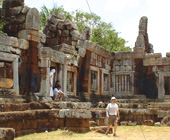
Phnom Chiso Pagoda was built in 1917, destroyed by war during the 1970s and rebuilt in 1979. Behind it is a hall called Thammasaphea, kof and a worship place. There is an ancient water 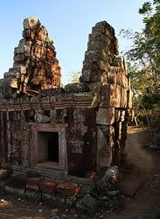 tank made of concrete. People usually climb the staircase on the west side of the mountain, which has 390 steps and descend by the south side staircase, which has 408 steps. Another set of stairs in front of the temple links the temple to Sen Chhmos temple, Sen Phouvang temple and Tonie Om, a lake considered sacred by Brahmans and used for washing away sins. A large rock yard nearby about 100 meters long and 80 meters was once the site of several other temples, but only parts of these temples remain standing.
tank made of concrete. People usually climb the staircase on the west side of the mountain, which has 390 steps and descend by the south side staircase, which has 408 steps. Another set of stairs in front of the temple links the temple to Sen Chhmos temple, Sen Phouvang temple and Tonie Om, a lake considered sacred by Brahmans and used for washing away sins. A large rock yard nearby about 100 meters long and 80 meters was once the site of several other temples, but only parts of these temples remain standing.
In addition, there is a mountain cave, Vimean Chan, located about 150 meters south of the temple. It is a quiet place for Brahmans or ascetics to meditate. During the Americans' war with Vietnam, the site was bombed, dislodging several large rocks that block the entrance to the cave today.
Hun Sen Phnom Chiso Agricultural and Tourist site is located in Samrong, Bati and Prey Kabas districts. It includes a 513 hectare paddy rice field of dry rice, a 1,386 hectares field of wet rice and three water basins - Thnos Ta Kong, Tuol Lork and Sen Pea Ream.
Phnom Chiso is very popular with visitors, especially during festivals, when it is very crowded. The top of the mountain affords visitors a panoramic view of Takeo Province rice paddies stretching for kilometers.
Phnom Ta Mao (Zoo)
 Phnom Ta Mao (Zoo) How to go: Location: Description: Located at Tro Pang Sap village, Tro Pang
Phnom Ta Mao (Zoo) How to go: Location: Description: Located at Tro Pang Sap village, Tro Pang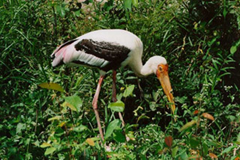 Sap commune, Ba Ti District, Takeo province. Phnom Tamao can be accessible by the National Road No 2 in 40-kilometre distance from Phnom Penh. Then turning right more five kilometers by a trail, it takes 45-minute drive from Phnom Penh. Phnom Ta Mao is a varied site consisting of temples, mountain, nature and a big zoo in Cambodia. Phnom Ta Mao has 2,500-hectar land area called forest-protected area; in this area, the Department of Forestry has taken 1,200-hectar land area for planning trees and 70-hectar land area for organizing zoo. The 70-hectar landarea consisting of five mountains namely: Phnom Ta Mao, Phnom Thmor Dos, Phnom Phdan Poan, Phnom Chhoy and Phnom Bang. Among the five mountains, two mountains have ancient temples are: - Ta Mao Temple (is located at Phnom Ta Mao): was built in 11th century during the reign of the king, Soryak Varman I dedicated to Brahmanism, the temple made of Thmor silt and red-solid brick, located on the peak of 30-meter mountain of Ta Mao, near Ta Mao pagoda. Now, the temple is damaged and is almost unrecognizable. - Thmor Dos Temple (is located at Phnom Thmor Dos): The temple is located on a 35-meter mountain of Thmor Dos, Northwest of Ta Mao temple and was built in 11th century. The temple made of Thmor silt mad red-solid brick. Now, most of the temples are damaged. The people want to go to this temple to worship than Ta Mao temple. In addition, Phnom Ta Mao has a big zoo in Cambodia; the zoo is under the supervision of the Department of Forestry, Ministry of Agriculture and has 84 varieties of animals and birds; two kinds of them are brought from abroad. - There are 150-fourfooted animals consisting of 38 kinds. - There are 300 birds consisting of 38 kinds. - There are 30 reptiles consisting of eight kinds. All these animals are brought here by the Ministry of Agriculture and by seizing from offenders who illegally traffic in wild animals through out Cambodia. To take care these animals, we need to expend US$ 120 per day for food, and 22 staff and workers are working there. The average number of tourists visiting Phnom Ta Mao is 500-600 visitors per week; but during the festivals, there are 7,000-8,000 visitors per week. The local people of four communes around the Phnom Ta Mao are earning money from selling food to tourists. We can extend package-tour program to the above two resorts because these resorts are the popular sites for local and international tourists, and their location is near Phnom Penh. As the sites can attract many tourists, we expect to lure investors to invest in tourist facilitation and constructing the trail from the national Road No 2 to the resorts. The Department of Forestry has a project on constructing an inside trail linking from Tonle Ba Ti to Phnom Ta Mao in Six-Kilometre distance.
Sap commune, Ba Ti District, Takeo province. Phnom Tamao can be accessible by the National Road No 2 in 40-kilometre distance from Phnom Penh. Then turning right more five kilometers by a trail, it takes 45-minute drive from Phnom Penh. Phnom Ta Mao is a varied site consisting of temples, mountain, nature and a big zoo in Cambodia. Phnom Ta Mao has 2,500-hectar land area called forest-protected area; in this area, the Department of Forestry has taken 1,200-hectar land area for planning trees and 70-hectar land area for organizing zoo. The 70-hectar landarea consisting of five mountains namely: Phnom Ta Mao, Phnom Thmor Dos, Phnom Phdan Poan, Phnom Chhoy and Phnom Bang. Among the five mountains, two mountains have ancient temples are: - Ta Mao Temple (is located at Phnom Ta Mao): was built in 11th century during the reign of the king, Soryak Varman I dedicated to Brahmanism, the temple made of Thmor silt and red-solid brick, located on the peak of 30-meter mountain of Ta Mao, near Ta Mao pagoda. Now, the temple is damaged and is almost unrecognizable. - Thmor Dos Temple (is located at Phnom Thmor Dos): The temple is located on a 35-meter mountain of Thmor Dos, Northwest of Ta Mao temple and was built in 11th century. The temple made of Thmor silt mad red-solid brick. Now, most of the temples are damaged. The people want to go to this temple to worship than Ta Mao temple. In addition, Phnom Ta Mao has a big zoo in Cambodia; the zoo is under the supervision of the Department of Forestry, Ministry of Agriculture and has 84 varieties of animals and birds; two kinds of them are brought from abroad. - There are 150-fourfooted animals consisting of 38 kinds. - There are 300 birds consisting of 38 kinds. - There are 30 reptiles consisting of eight kinds. All these animals are brought here by the Ministry of Agriculture and by seizing from offenders who illegally traffic in wild animals through out Cambodia. To take care these animals, we need to expend US$ 120 per day for food, and 22 staff and workers are working there. The average number of tourists visiting Phnom Ta Mao is 500-600 visitors per week; but during the festivals, there are 7,000-8,000 visitors per week. The local people of four communes around the Phnom Ta Mao are earning money from selling food to tourists. We can extend package-tour program to the above two resorts because these resorts are the popular sites for local and international tourists, and their location is near Phnom Penh. As the sites can attract many tourists, we expect to lure investors to invest in tourist facilitation and constructing the trail from the national Road No 2 to the resorts. The Department of Forestry has a project on constructing an inside trail linking from Tonle Ba Ti to Phnom Ta Mao in Six-Kilometre distance.Yeay Pov temple is behind Wat Tonle Bati, about 100 meters from Ta Prohm temple. Constructed of sandstone in the 12 century, it is 7 meters square and faces east. Apart from the temple is a house on the bank of Tonle Bati, about 200 meters from the temple, that once was used by the royal family during holidays. Today this place houses the offices of Bati Tourism Company, which controls the 9.3 hectare site. The company has erected 48 resting cottages with zinc roofs and another 40 cottages with leaf roofs along the riverside. The company has also built nine restrooms, and other restrooms are available at local people's residences.
In additional, there is also a natural lake that is 7,000 meters long. During the dry season, the lake is 1,000 meters wide and 1 to 2.5 meters deep. During the rainy season, it swells to 1, 500 meters wide and is about 4 meters deep. There is a fee to enter the site. The cost for cambodian is 1,000 riel (USD0.25) for motobikes and 2,000 riel (USD0.50) for cars. The fee for resting cottages is 5,000 riel (USD1.25) per cottage. Foreigners are charged USD2 per person. Food can be purchased at the site. The site is very popular, attracting 500 to 600 Cambodians and 100 foreign visiter per week. During holidays and festivals, the number of visitors can reach 9,000 per week. The site also provide employment opportunities and a good living for the people of the nearby Thnal Teaksin and Tonle Bati villages.
Chup Pol Temple
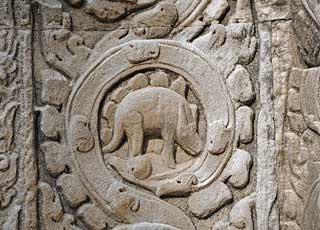 Chup Pol Temple, Takeo, popularly known as Chu Pol temple, is a coveted tourist spot. Cambodia is famous for its historical sites and edifices and Takeo is no exception. Chup Pol Temple, Takeo is one such structure that throws sufficient light on the historical and cultural aspect of the place.
Chup Pol Temple, Takeo, popularly known as Chu Pol temple, is a coveted tourist spot. Cambodia is famous for its historical sites and edifices and Takeo is no exception. Chup Pol Temple, Takeo is one such structure that throws sufficient light on the historical and cultural aspect of the place.
Chup Pol Temple, Takeo is a sacred site and the tourists make sure that they include this site in their travel itinerary. There are several tourist attractions in Takeo and they are broadly divided into historical sites and natural and wildlife preserves. The Chup Pol Temple, Takeo belongs to the category of historical buildings and sites.
Chup Pol Temple in Takeo is located in the wonderful Doun Peaeng Village. This village is situated in the Baray Commune region in the Doun Kae District. The reason for the popularity of this site is not just the fact that it is a historical edifice but also because it is very conveniently located. It is one of the tourist attractions in Takeo that is not more than 3 kms from the Provincial town. By car it takes hardly 5 minutes and sometimes tourists also prefer to walk all the way to the temple so that enroute they can study the surrounding locale. Chup Pol Temple is located in Doun Peaeng Village, Baray Commune, Doun Kae District, about 3 kilometers (4mn) from Provincial Town. It is the Historical Sites and Buildings.
Chruos Phaork Temple

Chruos Phaork, Takeo is one of the well known nature and wildlife preserves in Cambodia. This serene and beautiful preserve is situated in the Pou Village in Preah Bat Choan Chum Commune. Chruos Phaork, Takeo is in fact located in the Kiri ong District which, in general, boasts of grand sceneries and lovely foliage.
From the Provincial town the Chruos Phaork, Takeo is about 44 kms. Tourists will find sufficient conveyance and the journey is of a duration of 1 hour approximately. In this nature and wildlife preserve the tourists will get too see a lot of greenery. The flowers here are vibrant and colorful. Sometimes the tourists will find rare plants in the locale. It is indeed a delightful venture. Like most of the other natural and wildlife tourist attractions in Takeo at the Chruos Phaork too the tourists will find rare insects and birds too.
Chruos Phaork, Takeo is the perfect example of a well balanced bio-diversity. Flora and fauna live here in a kind of symbiosis. The tourists who have been to Chruos Phaork in Takeo love to come back and those who have not undertaken the journey should do so. If you are in Takeo then you cannot afford to miss the Chruos Phaork.




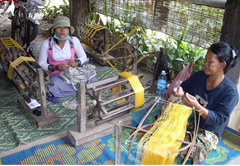
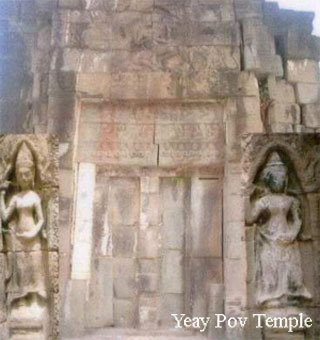
 The name Siem Reap means ‘Siamese Defeated’. Siem Reap was a little more than a village when the first French explorers re-discovered Angkor in 19th century.
The name Siem Reap means ‘Siamese Defeated’. Siem Reap was a little more than a village when the first French explorers re-discovered Angkor in 19th century. Siem Reap Town serves as the gateway to the millennium-old temple ruins of the Khmer Empire. Designated a World Heritage Site by UNESCO, the Angkor Archaeological Park encompasses dozens of temple ruins including Bayon, Banteay Srey and the legendary Angkor Wat whose artistic and archaeological significance and visual impact put it in a class with the Pyramids, Machu Pichu and the Taj Mahal. Unlike many other world class monuments, the ruins of Angkor are as yet unspoiled by over-development. This will not be true in a couple of years. Though the major temples are relatively well touristed these days, it is still possible get away from the crowds, to explore the area and discover Angkor.
Siem Reap Town serves as the gateway to the millennium-old temple ruins of the Khmer Empire. Designated a World Heritage Site by UNESCO, the Angkor Archaeological Park encompasses dozens of temple ruins including Bayon, Banteay Srey and the legendary Angkor Wat whose artistic and archaeological significance and visual impact put it in a class with the Pyramids, Machu Pichu and the Taj Mahal. Unlike many other world class monuments, the ruins of Angkor are as yet unspoiled by over-development. This will not be true in a couple of years. Though the major temples are relatively well touristed these days, it is still possible get away from the crowds, to explore the area and discover Angkor. 1. Take a boat cruise on the lake. The Tonle Sap lake is home to an enormous diversity of wildlife, as well as a number of stilt villages where you can witness traditional ways of life. Cambodia's Great Lake, the Boeung Tonle Sap (Tonle Sap Lake,) is the most prominent feature on the map of Cambodia - a huge dumbbell-shaped body of water stretching across the northwest section of the country. In the wet season, the Tonle Sap Lake is one of the largest freshwater lakes in Asia, swelling to an expansive 12,000 km2. During the dry half of the year the Lake shrinks to as small as 2500 km2, draining into the Tonle Sap River, which meanders southeast, eventually merging with the Mekong River at the 'chaktomuk' confluence of rivers opposite Phnom Penh.
1. Take a boat cruise on the lake. The Tonle Sap lake is home to an enormous diversity of wildlife, as well as a number of stilt villages where you can witness traditional ways of life. Cambodia's Great Lake, the Boeung Tonle Sap (Tonle Sap Lake,) is the most prominent feature on the map of Cambodia - a huge dumbbell-shaped body of water stretching across the northwest section of the country. In the wet season, the Tonle Sap Lake is one of the largest freshwater lakes in Asia, swelling to an expansive 12,000 km2. During the dry half of the year the Lake shrinks to as small as 2500 km2, draining into the Tonle Sap River, which meanders southeast, eventually merging with the Mekong River at the 'chaktomuk' confluence of rivers opposite Phnom Penh.







![clip_image002[26] clip_image002[26]](http://lh6.ggpht.com/-4-cR-6PGM_E/Th3OuADEdzI/AAAAAAAAABY/19WylWbgIuw/clip_image002%25255B26%25255D_thumb%25255B4%25255D.gif?imgmax=800)
 Svay (pronounced Swai) Rieng is on of the smallest and sleepiest Cambodian provinces that just happen to have one of the country's busiest highways running straight through - National Highway No 1, which links Phnom Penh and Ho Chi Minh City in Vietnam just after you cross the Mekong River by way of the Neak Loeung Ferry. It is also one of the poorest provinces of Cambodia due to the poor quality of the land. Most of the provincial population eke out a subsistence living based on farming and fishing. Svay Rieng is the provincial capital, a sleepy town just 43 km from the Bavet border crossing. This is a fairly prosperous place as a result of the border trade traffic, business people and travellers passing trough. The town is a very friendly place and makes for a pleasant overnight stop whether coming from or going to Vietnam.
Svay (pronounced Swai) Rieng is on of the smallest and sleepiest Cambodian provinces that just happen to have one of the country's busiest highways running straight through - National Highway No 1, which links Phnom Penh and Ho Chi Minh City in Vietnam just after you cross the Mekong River by way of the Neak Loeung Ferry. It is also one of the poorest provinces of Cambodia due to the poor quality of the land. Most of the provincial population eke out a subsistence living based on farming and fishing. Svay Rieng is the provincial capital, a sleepy town just 43 km from the Bavet border crossing. This is a fairly prosperous place as a result of the border trade traffic, business people and travellers passing trough. The town is a very friendly place and makes for a pleasant overnight stop whether coming from or going to Vietnam. Svay Rieng is a small low land province with 2,966 square kilometres. Majority of land is arable land and it is under Mekong water half a year. It?s located in the Southeast of the country bordering Kampong Cham to the North, Prey Veng to the West and Vietnam to the East and South. The Southeast of the province occupies a jut of land sticking into Vietnam, so the Southeast of the province is literally surrounded from Vietnam. The province consists generally of the typical plain wet area for Cambodia, covering rice fields and other agricultural plantations. The land state is due to the American carpet bombing a real pity no forests and cratered countryside are the results.
Svay Rieng is a small low land province with 2,966 square kilometres. Majority of land is arable land and it is under Mekong water half a year. It?s located in the Southeast of the country bordering Kampong Cham to the North, Prey Veng to the West and Vietnam to the East and South. The Southeast of the province occupies a jut of land sticking into Vietnam, so the Southeast of the province is literally surrounded from Vietnam. The province consists generally of the typical plain wet area for Cambodia, covering rice fields and other agricultural plantations. The land state is due to the American carpet bombing a real pity no forests and cratered countryside are the results.  Located 48 kilometers from Svay Rieng provincial town is the international border with Vietname. The Bavet checkpoint is the main international border crossing for people traveling between Phnom Penh and Ho Chi Minh City.Bavet's main attractions are two casinos that are within short walking distance of the border. This casinos are very popular with foreigners crossing the border. There is also a market, Psar Nat, where goods are transferred between Cambodia and Vietnam.
Located 48 kilometers from Svay Rieng provincial town is the international border with Vietname. The Bavet checkpoint is the main international border crossing for people traveling between Phnom Penh and Ho Chi Minh City.Bavet's main attractions are two casinos that are within short walking distance of the border. This casinos are very popular with foreigners crossing the border. There is also a market, Psar Nat, where goods are transferred between Cambodia and Vietnam. Brasoth Center is located in Prasout Commune, Svay Teab district, about 1.5 km (10mn) from Provincial Town. Operation of Sporting Facilities.
Brasoth Center is located in Prasout Commune, Svay Teab district, about 1.5 km (10mn) from Provincial Town. Operation of Sporting Facilities. Prey Ba Sake Located in Svay Rieng District at the Southeast of the provincial town in the distance of 8.5 kilometres from the provincial town. The area of Prey Ba Sak has 84 square meters and borders river of Vag Ko at the North and the East, village of local people at the west and the South.
Prey Ba Sake Located in Svay Rieng District at the Southeast of the provincial town in the distance of 8.5 kilometres from the provincial town. The area of Prey Ba Sak has 84 square meters and borders river of Vag Ko at the North and the East, village of local people at the west and the South. 
 Kampong Chhnang is located at the heart of Cambodia. Its bordering Kampong Thom to the North, Kampong Cham to the East, Kampong Speu to the South and Pursat to the West. This province is not only at the fertile and almost ever-wet heart of Cambodia, but also just a 91km ride from Phnom Penh, so it's a quick jaunt up.
Kampong Chhnang is located at the heart of Cambodia. Its bordering Kampong Thom to the North, Kampong Cham to the East, Kampong Speu to the South and Pursat to the West. This province is not only at the fertile and almost ever-wet heart of Cambodia, but also just a 91km ride from Phnom Penh, so it's a quick jaunt up.  14km (1h) From Provincial Town. You will take about an hour to travel to Phnom Neang Kang Rey, Kampong. For the tourists and travelers, there are regular buses and cars available from all parts of Cambodia. Phnom Neang Kang Rey is a natural wildlife preserve. Phnom Neang Kang Rey, Kampong Chhnang is situated in the Trabek Village in the Trangil Commune at the Kom Pong Leng District of Cambodia.
14km (1h) From Provincial Town. You will take about an hour to travel to Phnom Neang Kang Rey, Kampong. For the tourists and travelers, there are regular buses and cars available from all parts of Cambodia. Phnom Neang Kang Rey is a natural wildlife preserve. Phnom Neang Kang Rey, Kampong Chhnang is situated in the Trabek Village in the Trangil Commune at the Kom Pong Leng District of Cambodia.  Phnom Roap Bat, Kampong Chhnang is one of the best and finest of the natural resorts of the Kampong Chhnang province in the beautiful and historical country of Cambodia, about 12 kilometers south of Kampong Chnnang provincial town.
Phnom Roap Bat, Kampong Chhnang is one of the best and finest of the natural resorts of the Kampong Chhnang province in the beautiful and historical country of Cambodia, about 12 kilometers south of Kampong Chnnang provincial town.  Phnom Santouch is a natural site located at Santouch village, Sre Thmei commune, Rolea Paear district, about 3 kilometers north of the provincial town. The local people usually visit Phnom San Touch for its tranquility, peacefulness and strategic location. There are many big rocks related to Cambodian folk legend here. The place is so scenic that you many films have set their stories and performance of songs in the Phnom San Touch, Kampong Chhnang.
Phnom Santouch is a natural site located at Santouch village, Sre Thmei commune, Rolea Paear district, about 3 kilometers north of the provincial town. The local people usually visit Phnom San Touch for its tranquility, peacefulness and strategic location. There are many big rocks related to Cambodian folk legend here. The place is so scenic that you many films have set their stories and performance of songs in the Phnom San Touch, Kampong Chhnang. Phnom Krang Romeas is located in Sre Thmei and Svay Chrum communes, Rolea Paear district, about 2 kilometers from the provincial town.
Phnom Krang Romeas is located in Sre Thmei and Svay Chrum communes, Rolea Paear district, about 2 kilometers from the provincial town.
 How far: 3km (3mn) From Provincial Town. Phnom Ta Ind, Kampong Chhnang has seen many migratory birds and animals.
How far: 3km (3mn) From Provincial Town. Phnom Ta Ind, Kampong Chhnang has seen many migratory birds and animals. Located at Wat kampong Preah, Chhnuk Tru Commune, Boribo District in eight-Kilometer distance from the provincial town.
Located at Wat kampong Preah, Chhnuk Tru Commune, Boribo District in eight-Kilometer distance from the provincial town. Prasat Slut Tey located in Prasat Village, Da Commune, kompong Leng District about 27 km (1h:30mn) From Provincial Town.
Prasat Slut Tey located in Prasat Village, Da Commune, kompong Leng District about 27 km (1h:30mn) From Provincial Town. Tonle Sap view area is located in front of Phsar Krom, about 1 kilometer from the provincial town. The Tonle Sap is a very large river, which at one point becomes as wide as a lake. Traveling along this river is an interesting way to reach Siam Reap from Pnomh Penh.
Tonle Sap view area is located in front of Phsar Krom, about 1 kilometer from the provincial town. The Tonle Sap is a very large river, which at one point becomes as wide as a lake. Traveling along this river is an interesting way to reach Siam Reap from Pnomh Penh.










